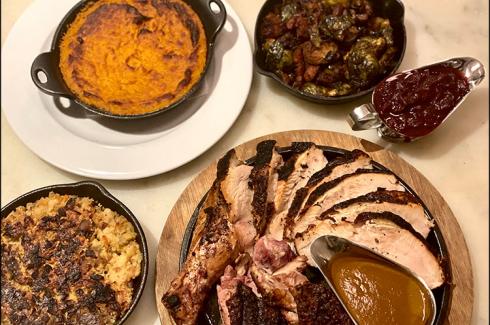Broccoli was not discovered by Americans sometime in the ’20s as this fabled magazine caption suggests. (There WAS life before salad too.) Broccoli and other cruciferous vegetables were common on Colonial tables, but somehow got lost by their descendants. Although such truck, as broccoli, kale, chard, and a green known confusingly to Italians and precious few others as broccoli rabe, broccoli rapa, and the abbreviated rape have been around for centuries, many cooks still have no idea of what to do with them. In England, where you can’t tell one from the other anyway, all the leafy, mineral, and ironladen vegetables are called simply “greens.”
Mrs. Mary Randolph gave her recipe for broccoli in the “Williamsburg Art of Cookery,” 1831 edition.
“Brocoli"
“The Kind which bears Flowers around the Joints of the Stalks must be cut into convenient Lengths for the Dish; scrape the Skin from the Stalk, and pick out any leaves or Flowers that require to be removed; tie it up in Bunches and boil it as Asparagus; serve it up hot, with melted Butter poured over it. The Brocoli that heads at the Top like Cauliflowers must be dressed in the same Manner as the Cauliflower. ”
Note: Modern broccoli stalks should always be peeled just as Mrs. Randolph says. However, broccoli with flowers should be shunned as it is over the hill, the horse is out of its stall, or another goofy aphorism. For the best color and flavor, though not necessarily maximum vitamins, boil the vegetable in a large open pot of salted water until the peeled stems are crisp-tender. (Steaming is another attractive alternative though not so brilliantly green when served.) Drain and serve at once with melted butter or, best of all, heavenly Hollandaise.
Swiss Chard
Chard, a large-leafed green that resembles spinach, comes in two shades: red stemmed and white stemmed. The stems, even if young and fresh, must be peeled and quickly cooked — like the broccoli above — and served with butter or a sauce. The leaves and stalks (which are the “chards”) are never cooked together as the leaves need only a rapid blanching. I have no idea why chard is dubbed “Swiss.”
Chard And Lentil Soup
Deeply earthy and healthy, this soup is a paradox because it is satisfying, yet light. The color, a dullish green from the chard, takes a bit of getting used to, but give it a try. I used the French green lentils because they hold their shape better than the commoner brown ones (which also get muddier looking but nevertheless will do). A good reviving soup for leaf-raking fanatics. Makes approx. two quarts.
1 cup cooked, shredded chard leaves (see note)
2 quarts lightly salted water
1 cup dried green French lentils
3 Tbsp. olive oil
2 fat cloves garlic, minced
1 medium onion, minced
1/2 cup celery, minced
1 cup thinly sliced raw potatoes
1 or 2 chicken bouillon cubes
1 tsp. dried thyme
1 bay leaf
3 beef frankfurters
Note: Wash the chard as you would spinach — lifting it from its rinse water twice. Strip the stalks from the leaves. Roll up the leaves and shred them with a knife or food processor. Cook in boiling water for about three minutes, remove, drain well, preserving liquid, and use as you would spinach — in quiches, timbales, soups, or as a vegetable.
The chard is cooked first, then added last, just to heat up. Wash and pick over the lentils, then add them to the chard broth. Bring to the simmer while you saute the garlic, onion, and celery in olive oil. Add this and the potatoes and bouillon cubes to the lentils along with the herbs. Simmer about 20 minutes or until potatoes and legumes are tender. Boil the frankfurters separately and cut them in half-inch lengths. Stir the cooked chard into the soup, heat briefly, then ladle into hot soup bowls and put a spoonful of hot frankfurter chunks over the top. Kielbasa is good too, but it does tend to overwhelm the soup flavors. Serve with sturdy rye bread and fresh, sweet butter or with hot cornbread. This soup is vaguely reminiscent of “pot likker” in Southern cookery.
Broccoli di Rapa (Rape)
Pronounced RAH-pay, this leafy green has a forceful character and is excellent with pasta or in lusty soups such as vegetable with dried beans. Sicilians and Neopolitans are especially devoted to rapa. This autumn greenery needs thorough washing and stemming.
Rapa With Buckwheat Noodles
“The Greens,” which is about the only truly inspired vegetarian cookbook I have ever seen, was the genesis of this dish, which isWonderful served with spicy Italian grilled sausages for meat-eaters (called “carnivores” by certain prissy vegetarians). Homemade noodles are sensational, but you can substitute Japanese “soba” which are dried buckwheat noodles. Serves three to four.
1 recipe buckwheat noodles
Large bunch of broccoli di rapa
1/2 cup olive oil
3 or 4 cloves fresh garlic, sliced
Salt and pepper to taste
Freshly grated Parmesan
1/4 cup toasted pine nuts or walnuts
Make the noodles, cut them, and let them dry for about ten minutes before boiling them ever so swiftly — they just pass through the boiling water. Prepare all else before cooking fresh noodles.
Buckwheat Noodles
1/3 cup unbleached flour
1/3 cup buckwheat flour
Big pinch of salt
1 jumbo egg
1 tsp. olive oil
Mix the two flours in a food processor or by hand. Add the salt, egg, and oil and pulse the processor (or mix by hand) until the dough forms a mass. Turn this out and knead well on a smooth surface. ('Fry to avoid adding water — beating the egg before putting it into the flour usually averts the necessity of chancing a wet dough that is impossible to roll and cut.)
Refrigerate for an hour to relax the gluten in the flour, then roll out the dough thinly (in a pasta machine or by hand), and cut into one-fourth inch or narrower strips. Divide this into two or four clumps and set aside until the lucky diners are seated at the table, forks up-raised.
Cooking the Rapa
This leafy veg should be dark green, fresh, and dewy. Strip its coarser stems away and wash and spin dry the rest. Heat the olive oil and gently saute the garlic until golden, then discard it (otherwise it becomes black and bitter when the rapa is cooked). Add the rapa, coarsely chopped if large-leafed, and stir-fry until it wilts, seasoning as the greens reduce. 'Toast the pine nuts and put the cheese on the table; have hot pasta bowls at the ready. Cook the noodles as directed, use a big pasta scoop to get them directly into the waiting bowls, distribute the rapa over them, and scatter this with pine nuts. Serve presto! Pass the fresh grated Parmesan at table.
Homemade noodles are too much trouble for mass feedings — use the Japanese “soba” then — but extraordinary to offer to a few of the near and dear. I have only a small Italian hand-cranked machine, not one of those major-league pasta machines, and I still think homemade pasta is worth doing occasionally.





